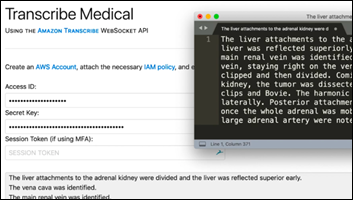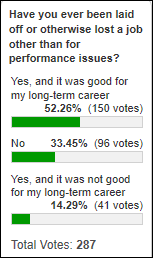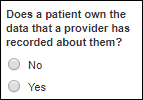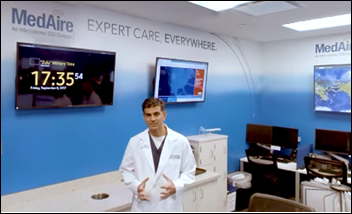Doug Cusick, PharmD is president and CEO of TransformativeMed of Seattle, WA.

Tell me about yourself and the company.
I’m a clinician by background, although I’ve not practiced for many years. I’ve been in the electronic health industry for 35 years and I have the gray hair to prove it. I spent five of those years overseas, running a large healthcare and life sciences division for a large technology and services company.
TransformativeMed was a spinout from the University of Washington back in about 2012. It was co-founded by a practicing trauma surgeon, who continues to practice, and at that time the applications director at the University of Washington, who had overseen its Cerner implementation. The two of them together quickly saw a need to make the EHR usable, primarily for the doctors.
Does offering products that extend Cerner’s system limit the company’s opportunities?
The applications director was one of the inventors of MPages, which is used by organizations — including Cerner — to develop customizations to the Cerner Millennium software. The co-founders recognized that the EHR was just a platform, and in many cases, one that was challenging for clinicians to use. They went about inventing a series of applications that are embedded within Cerner and that have bi-directional information exchange. That allows specialty-specific workflows to be built.
By example, if you’re an endocrinologist, you need certain data at certain times in the decision-making process as part of the hospital’s overall care team. You want it in the format that is intuitive to how you practice. They developed 40 specialty-specific and subspecialty-specific clinical workflows.These are embedded in the clinical workflow, where all the action happens. Those users can manage their patient lists, the rounding and hand-off process, and care team coordination. They can also take advantage of disease-specific workflows, such as inpatient diabetes management and thrombolytics.
We continue to consume more and more of the breadth and the depth of what the clinicians need in order to make the electronic health record usable. We are moving pretty broadly across that realm.
What kind of relationship with Cerner do you need to make this work? How would that translate into working with Epic?
Our solutions are built on cooperating with the large electronic health vendors. It’s like the Salesforce model, with a great platform that is open for innovations. Cerner specifically is that type of platform. We rely on the data that is populated in the EHR. Our solutions allow that data to flow between the apps and the EHR, because it is embedded within the databases themselves.
In many cases, particularly with Cerner, the client representatives themselves come to us to help solve problems around clinician satisfaction, gaining efficiencies, and delivering on the billions of dollars that have been invested in the EHR.
It’s funny that in my 35 years in this industry, I can count on one hand how many doctors and IT people have ever said anything positive about any software solution. But in our case, what was so attractive for me coming on as CEO was that I get emails and phone calls every day from doctors and IT folks who love our embedded applications products that make their EHR usable, particularly from a specialty-specific perspective. It’s pretty amazing that for the first time in my career, we get so many kudos because doctors and IT folks love us.
How do you see the company growing? Do you hope to replicate your success in having helped other companies move up to the next level?
[Laughs] Absolutely yes, and most certainly. What was so attractive about me coming on board was that I had never seen anything like it. It isn’t disruptive to IT. Doctors and clinicians truly love us because we make their day better by delivering solutions that are intuitive to how they practice medicine. That we don’t need trainers on site speaks to the intuitiveness.
We recently went through a fairly substantial series A raise in Seattle. Before that, we were moving the company forward on customer revenue, and most of those sales had been done by word of mouth. For example, clinicians practicing at the University of Washington were moving on to other health systems and logging onto the EHR and saying, “This isn’t what I’m used to. I really need Cores,” which is the name of our product line.
When I came on board, we had a pretty nice array of clients and we’ve expanded that dramatically. I think we’re up to about 140 or so hospitals in the US. We’re selling our first international deal this week, so we’re pretty excited to expand internationally as well. Cerner has a large footprint.
We will be cautiously moving into Epic. We just closed our first contract with a health system that is moving to Epic. We couldn’t be more excited about gaining that experience, especially as interoperability and FHIR begin to take hold of the industry.
What business arrangement do you have with those EHR vendors?
We do not have a formal business relationship with them. We contract directly to the health systems. But with so many articles being published around physician burnout and lack of efficiencies and crises galore, the EHR vendors are seeing opportunity to deliver more innovation through their platform. The EHR is just data storage and the ability to move data around.
Health systems are recognizing that the EHR vendors aren’t going to deliver everything they possibly need. With the amount of true innovation that is going on across the industry, how can they add applications that make it more usable in a standardized fashion, but personalized for the clinicians who have to use it?
Particularly in this era of EHR optimization, we need to move way beyond the re-implementation of the EHR as the industry currently conceives it. EHRs need a massive overhaul to make them usable by the clinical community, and we have lots of studies to support that. CIOs are beginning to recognize, along with the clinical community, that they have a responsibility to help solve some of the problems.
It’s surprising that you can work with Epic without the company’s participation, and also that you can create add-on products without having problems when Cerner or Epic upgrade their underlying EHR.
MPages allows us to be directly embedded within the Cerner databases and all clients use it. Once we are given access to the system, it becomes our heavy lift and not an IT department burden, so CIOs love us. Plus, we are delivering huge benefits to the clinical community, namely the doctors who are finding that it is much more usable.
Epic is a different model and a more closed architecture. But we’re finding, particularly today in our first engagement, that Epic has been collaborative in terms of bringing our solutions within this health system. We’ll go live with them later in 2020. We couldn’t be more excited about the opportunity to move further into the EHR world. And not just here — the problems we face are being seen worldwide as more countries and systems purchase American EHRs.
EHRs weren’t necessarily designed for physician shift work and the resulting handoffs, such as hospitalists covering large numbers of patients for a fixed period, residents whose work hours are limited, and the use of multidisciplinary care teams. What does the market need beyond basic EHR functionality to support that model?
IT needs to become more interoperable. The 21st Century Cures Act is helping drive that interoperability forward, but health IT vendors as a whole are slow to comply.
I can use my phone to take a picture, edit it before texting it to my kids, share it on Facebook or Instagram, and my sister can download it and post it to her Nixplay electronic picture frame. This is real interoperability, and it should translate to healthcare because consumers expect it.
Doctors and other clinicians are spending so much time today away from the bedside and tied to a device – desktop or mobile – trying to get the data they need to make decisions. They need solutions that make it seamless and allow them to function as part of a care team. In the old days, you had just one doctor, like Marcus Welby, MD, but today that’s not the case. How do we continue to coordinate care across the health system to get the individual clinicians what they need immediately to make clinical decisions that positively affect the patient?
Our philosophy is about making that seamless communication and hand-off process as beautiful as possible so that clinicians can get back to the patient. They can deliver care as they’ve always wanted to. They are not tied to a computer to get the data they need in hunt-and-peck fashion. They go about doing their business and, in the process, become happier, and happy clinicians deliver better patient care.
Health systems, because they’ve invested so many billions, are now trying to figure out how to derive further value after these purchases. Companies like ours that are delivering innovation directly into the clinical workflow, where all the action happens, will be important. Because we’ve had such a substantial jump on it for the last seven years or so, we’re excited about the opportunity moving forward.
Beyond usability, EHR-related burnout seems related to the timing of system interruptions or guidance and the lack of workflow cohesiveness. Does that differ across specialties?
Absolutely. Consider the difference between what an endocrinologist may require when making a decision versus the oncologist. Although there are standards of practice, each specialty requires certain elements of data in a certain format that’s intuitive to how they practice medicine so that they can acquire that data with just one click, get everything they need, review the most appropriate and non-nuisance decision support, and then pass that on to the rest of the team.
That approach has garnered improvements in clinician satisfaction and efficiency. Instead of spending an hour and a half preparing for rounding, as some residents do, they don’t have to prepare. It’s right there for them, everything they need to do for rounding and hand-off. Those kinds of gains are making a huge difference, recognizing that some personalization needs to be done, but in a standard fashion.
Less than 1% of our solutions are ever customized because they are already intuitive to how the specialists practice medicine. That makes a huge difference, particularly with IT and the implementation process itself. Instead of taking 12, 15, or 18 months to implement a big EHR, we’re providing our applications from start to finish in less than 90 days. That’s a huge opportunity for doctors and executives to get those quick wins that deliver value immediately.
What prevents EHR vendors from using your ideas to develop competing functionality?
In the Salesforce model, these big vendors can only do so much, and they have a heavy lift across the entire system. As companies like ours begin to specialize and create niche markets, particularly for us around clinical workflows and disease-specific workflows, it’s easy for a health system just to drop it in and use it without the big lifts that they are traditionally used to with the big EHR vendors.
How will your business change as EHR vendors start using technologies from Amazon, Google, and Microsoft?
The difference is being truly embedded within the clinical workflows. The struggle in the industry is that a lot of great companies are doing a lot of great things, but they’re doing it from the outside, trying to get in. You have to toggle over to another system, or do something that disrupts the clinical workflow. We are clinicians and we are deeply embedded within the clinical workflow, where everything’s actionable. If you are using our secure messaging system, you get an alert that a particular patient’s creatinine level is high. It’s important to be able to take action from that message within the clinical workflow.
There’s much disruption and opportunity across the industry, everything from machine learning to artificial intelligence and certainly population health and analytics. Sometimes just getting the basics right around making it more usable in the clinical workflow for the clinicians is the huge opportunity. These players, Amazon included, are making huge strides in making the practice of healthcare delivery better. We welcome all of the opportunity, because it will change all of our lives, help us deliver better patient care, reduce cost, and produce better outcomes. We welcome the opportunity for companies like Amazon and Microsoft, which has now stepped back in in a dramatic fashion, because it means that healthcare will be better.
Do you have any final thoughts?
As we continue to see the industry mature, EHRs will become the platform where data is entered and stored. Companies like ours will make it innovative and useful to those who interact with it every day. This is the most change I’ve seen in 30 years, particularly as EHRs have become standard and problems had begun to arise that were never anticipated, problems that we have begun to fix across many health systems. I couldn’t be more excited to be in the industry. I still have the passion and the drive to deliver the change that we’re expecting, and it feels really good.
Comments Off on HIStalk Interviews Doug Cusick, CEO, TransformativeMed

































































 ‘
‘






"A valid concern..." Oh please. Everyone picks the software they like and the origin of that software is an afterthought.…